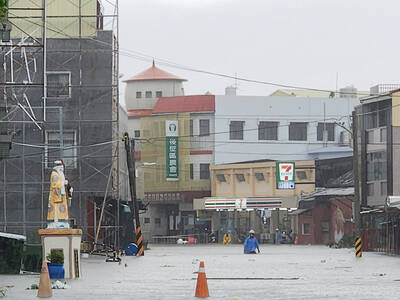More than a decade ago, a tiny start-up called Corbis set out to buy the rights to digitally reproduce many of the world's most revered paintings and photographs. The idea, in the view of the company's owner and founder, was that people would someday decorate their homes with digital artwork by displaying the images on flat-screen monitors.
These days, Corbis is still owned by its founder, Microsoft's chairman, Bill Gates, who designed his home to display digital artwork on flat-screen monitors. But Gates has little to do with the day-to-day operation of the company, whose mission has evolved.

PHOTO: NY TIMES
After acquiring 11 companies and the digital rights to dozens of other major collections, Corbis has settled into the business of licensing images to news outlets, publishers and advertising companies. And while Corbis may not have changed the way homes are decorated -- other than Gates' -- the company and its chief competitor, Getty Images, have permanently altered the media licensing business.
Today, Corbis and Getty Images, both based in Seattle, fulfill slightly more than half their orders online, delivering the requested images to customers over digital networks. A process that only a few years ago might have required several weeks of a photo researcher's time can now take only a matter of hours, or minutes.
Consolidation
But the real change in this nearly US$2-billion-a-year industry is the extensive consolidation that has taken place. In the last few years, Corbis and Getty Images have gobbled up nearly all North America's major collections. And both have deserted the unproven consumer business almost entirely, instead refocusing themselves in the business-to-business market.
In 1995, Corbis took the biggest step when it bought the Bettmann archive, perhaps the most significant collection of historical photographs, including some 12 million images. While the archive generates only 7 percent of Corbis' revenues, its prestige draws attention to the rest of the Corbis collection, which includes the photographic archive of United Press International; Saba Press, a news agency; and Sygma, a photo agency based in Paris.
At the same time, Corbis has the rights to license digital reproductions of works from the Hermitage Museum in St Petersburg, Russia; the Ansel Adams collection; the Philadelphia Museum of Art; and the National Gallery in London. Despite its ownership of some of the image industry's greatest collections, in this business Gates' company is not the 350kg gorilla. That status belongs to Getty Images, the only publicly traded company in the image-licensing business and the largest industry player by a long shot. Founded by two former investment bankers, including Mark Getty, an heir to the Getty oil fortune, Getty Images controls 26 percent of the market while Corbis has 6 percent. Not bad for a company that did not enter the market until nearly six years after Gates laid down his stakes.
Since its founding in 1995, Getty Images has bought more than 24 collections, including Europe's largest historic assemblage of photographs, the Hulton. Last year, Getty bought two competitors, the Image Bank and Visual Communications Group, for US$183 million and US$220 million, respectively. In 1999, the company paid US$116 million for art.com, a wall art company, but sold it earlier this year.
With the major collections already acquired, what is left? The remaining two-thirds of the image-licensing and stock-photography market is a fragmented lot, made up of small, often local or single-subject, collections.
Moving to digital
Nearly every city has a handful of image-licensing companies serving local needs. But those, too, may soon find themselves looking for a buyer -- assuming they cannot come up with the money to digitize their own collections and retool their businesses for e-commerce.
Getty Images, for example, spent nearly US$130 million in 1999 and 2000 converting its prints and negatives to digital files and building its distribution network, and is expected to spend an additional US$70 million this year, said Keith Gay, an analyst at Thomas Weisel Partners in San Francisco. And Corbis will spend millions to finish digitizing the Bettmann archive as it transfers the collection to an underground storage site in Pennsylvania.
"Our view is that 100 percent of sales in North America will be on the Internet in three years, and we don't need a major technology invention to make it happen," said Jonathan Klein, chief executive of Getty Images, and the person generally credited with establishing Getty Images' early lead.
Analysts also say digital is the only way to go. "If you don't do it electronically, you're going to go out of business," said Peter Appert, media analyst at Deutsche Banc Alex Brown.
While Corbis and Getty Images compete, they also seem to have settled into fairly complementary roles. Getty Images' primary business is selling to advertisers and commercial publishers. Corbis, on the other hand, emphasizes editorial work, licensing its images primarily to news organizations and magazines.
But with advertising spending down, so is the number of news and magazine pages -- and thus demand for the offerings of Getty Images and Corbis. Getty Images' revenue is down about 3 percent compared with last year -- well off growth in excess of 20 percent the last few years. The company is forecasting revenue this year of just under US$500 million.
And as for Corbis, after 12 years in existence, the company has yet to show a profit, and earlier this year laid off 79 of its 1,300 employees. But its fortunes may be about to change; company executives say it is on track to become profitable in the fourth quarter of 2002. Steve Davis, who shares the title of chief executive with Anthony Rojas, estimates Corbis will have US$140 million in revenues this year.
Both Getty Images and Corbis may find there are other ways to expand, even in the currently dismal economic climate. For starters, Gay said, they may begin to capture business from the US$5 billion-a-year custom photo industry.

Rainfall is expected to become more widespread and persistent across central and southern Taiwan over the next few days, with the effects of the weather patterns becoming most prominent between last night and tomorrow, the Central Weather Administration (CWA) said yesterday. Independent meteorologist Daniel Wu (吳德榮) said that based on the latest forecast models of the combination of a low-pressure system and southwesterly winds, rainfall and flooding are expected to continue in central and southern Taiwan from today to Sunday. The CWA also warned of flash floods, thunder and lightning, and strong gusts in these areas, as well as landslides and fallen

WAITING GAME: The US has so far only offered a ‘best rate tariff,’ which officials assume is about 15 percent, the same as Japan, a person familiar with the matter said Taiwan and the US have completed “technical consultations” regarding tariffs and a finalized rate is expected to be released soon, Executive Yuan spokeswoman Michelle Lee (李慧芝) told a news conference yesterday, as a 90-day pause on US President Donald Trump’s “reciprocal” tariffs is set to expire today. The two countries have reached a “certain degree of consensus” on issues such as tariffs, nontariff trade barriers, trade facilitation, supply chain resilience and economic security, Lee said. They also discussed opportunities for cooperation, investment and procurement, she said. A joint statement is still being negotiated and would be released once the US government has made

SOUTH CHINA SEA? The Philippine president spoke of adding more classrooms and power plants, while skipping tensions with China over disputed areas Philippine President Ferdinand Marcos Jr yesterday blasted “useless and crumbling” flood control projects in a state of the nation address that focused on domestic issues after a months-long feud with his vice president. Addressing a joint session of congress after days of rain that left at least 31 dead, Marcos repeated his recent warning that the nation faced a climate change-driven “new normal,” while pledging to investigate publicly funded projects that had failed. “Let’s not pretend, the people know that these projects can breed corruption. Kickbacks ... for the boys,” he said, citing houses that were “swept away” by the floods. “Someone has

‘CRUDE’: The potential countermeasure is in response to South Africa renaming Taiwan’s representative offices and the insistence that it move out of Pretoria Taiwan is considering banning exports of semiconductors to South Africa after the latter unilaterally downgraded and changed the names of Taiwan’s two representative offices, the Ministry of Foreign Affairs (MOFA) said yesterday. On Monday last week, the South African Department of International Relations and Cooperation unilaterally released a statement saying that, as of April 1, the Taipei Liaison Offices in Pretoria and Cape Town had been renamed the “Taipei Commercial Office in Johannesburg” and the “Taipei Commercial Office in Cape Town.” Citing UN General Assembly Resolution 2758, it said that South Africa “recognizes the People’s Republic of China (PRC) as the sole